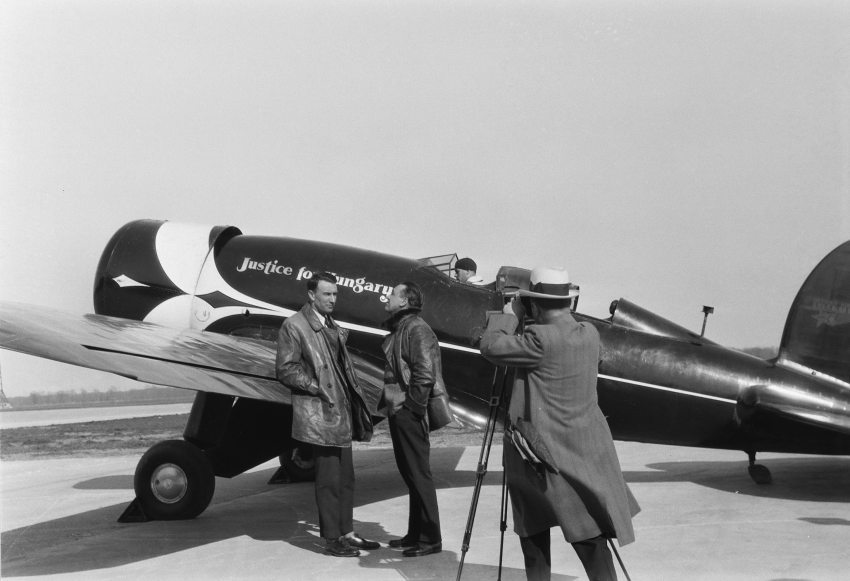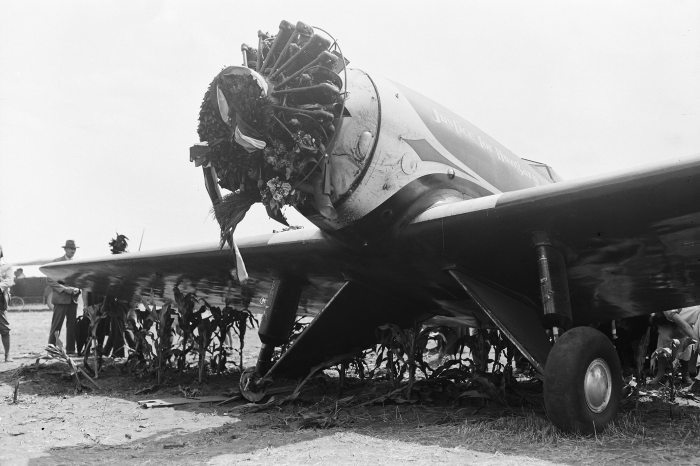"We did it, way to go" – The first Hungarian pilots over the Atlantic Ocean
In July 1931, the Hungarian press was full of the names of György Endresz and Sándor Magyar, the two Hungarian pilots who were the first from Hungary to cross the Atlantic. They covered the 5,770 kilometers between Newfoundland and Bicske, Hungary in twenty-five hours and twenty minutes, they had to make an emergency landing thirty kilometers from the finish due to running out of fuel, nevertheless, they set three world records.

Navigator Sándor Magyar and pilot György Endresz preparing to fly across the Atlantic Ocean, with the camera is Antal Bánhidi, mechanical engineer, aircraft designer – Photo: Fortepan/The Hungarian Museum of Science Technology and Transport – Archives – Negative Library – Hungarian National Museum, Hungarian Historical Picture Gallery
Over the Atlantic
The Wright brothers, Orville and Wilbur, used their fortune from bicycle manufacturing to experiment with aircraft in 1899. Their first plane took off in 1903, and they attempted to cross the Atlantic Ocean, but without success. The life-threatening adventure attracted pilots like a magnet, but the breakthrough came in 1927, with Charles Lindbergh becoming the first person to fly across the ocean without landing. The downturn in the world of aviation caused by the First World War and the economic depression of 1929 was felt, but Lindbergh's success opened a new chapter in aviation history. Crowd-pleasing air shows and air races became widespread, motivating manufacturers to improve their products.
Lockheed was the first company to start producing aircraft designed specifically for competition.
The wooden-framed, radial-engine planes of the past were replaced by metal airplanes, including the Lockheed Vega, in which Amelia Earhart became the first woman to cross the ocean in 1932.
Postcards for airplane
Inspired by Lindbergh's achievement, Sándor Magyar (Wilczek), a World War I war pilot who had emigrated to Canada, decided to become the first Hungarian to take on the challenge and chose fighter pilot György Endresz as his partner. The most important requirement was the purchase of a suitable aircraft. They chose the Lockheed Sirius, which Lindbergh had flown: the two-seater, single-engined, monoplane, four hundred and sixty horsepower type was the most suitable for the undertaking, but they did not have the necessary funds. The Hungarian immigrant community in the USA joined forces for a good cause, and the Detroit-based Hungarian American Transatlantic Committee was formed, which published and sold one-dollar postcards promoting Hungarian ocean flight.
A total of five thousand dollars was raised from the campaign, but it still proved insufficient. That's when Emil Szalay, a butcher-turned-meat plant owner living in America, stepped in and donated all his savings, a total of twenty-five thousand dollars, to the pilots. This was enough not only to buy the plane but also to cover the extra costs. The case was backed by the well-known press magnate of the day, the British Lord Rothermere, who supported the Hungarian revisionist demands and offered ten thousand dollars to the pair who'd complete the flight successfully.
The lord suggested painting the slogan Justice for Hungary on the side of the plane, reflecting on the decision made in Trianon.
5770 kilometres, 1520 minutes
Navigator Sándor Magyar and pilot György Endresz took off from Harbour Grace Airport near Newfoundland, Canada, at 17:20 local time on 15 July 1931. The destination was Budapest. Antal Bánhidi, an aviation engineer, helped them to adapt the aircraft to the long journey. Among other things, the cherry-red Lockheed Sirius was given more fuel tanks and the landing gear was modified. But despite the thorough preparations, the flight was not without problems.
Shortly after take-off, the ground induction compass failed, making navigation much more difficult, and this was exacerbated by adverse weather conditions, thick clouds and fog. The pilots used a telegraph to adjust their position with the help of ships on the route. After thirteen hours and fifty minutes, Magyar and Endresz reached Europe, near the coast of Ireland, and from there they continued their journey to Hungary. Travelling through thunderstorms and into a headwind, the fuel was running out faster than expected and by the time they reached Hungary, it had dropped to an alarming level. Near Bicske, less the 40 km from Budapest, the tank was completely empty and the engine stopped.
Endresz controlled the emergency landing, and after 5770 kilometers and twenty-five – according to some sources twenty-six – hours and twenty minutes of flight, he landed the plane in a cornfield between Felcsút and Csákvár. Sándor Magyar recalled the landing in his book Álmodni mertünk ('We Dared to Dream'): "Suddenly, a hay cart turns out of the yellow meadow in front of us. Endresz turns left with a great presence of mind. The wheels of the machine are already touching the ground as it turns. With a violent jolt, it jumps up and down, then stops with a jerk at the edge of the cornfield and slowly tips over on its head.
I jump out of the plane first, then Endresz. We stare at each other, speechless. Then Endresz looks at the machine and says sadly, "We did it, way to go."
He turns away and wipes his tears with his oily hands. With a mixture of oil and tears, he draws long lines across his face. I smile, he's laughing now."
Triple record
Although the plane suffered minor damage, with a broken propeller and damaged landing gear, the two pilots got out unhurt. They telephoned from the local post office to the airport in Budapest, where a crowd of tens of thousands awaited their arrival. "It was down to three litres of petrol that the Hungarian Jasons' masterpiece, the ocean flight, did not end with the aesthetic appearance that would have given a worthy frame to this magnificent achievement. There we waited and crowded on the pier of the harbour of Matyásföld, Budapest, the whole of official and unofficial Hungary, band and wreaths and the governor's tribune..." – Frigyes Karinthy writer and journalist reported from the scene for the Pesti Napló magazine.
Waiting did not dishearten those celebrating, "one of the old, experienced pilots of the Hungarian Air Traffic R.T. [...] took the two ocean pilots and landed with them at exactly nine o'clock at the Mátyás-föld airport, where the ecstatic crowd broke through all barriers and rushed towards the heroic pilots, whom they lifted up on their shoulders and carried in front of the radio microphone" – wrote the Dunántúl newspaper of 17 July 1931.
Although opinions differ about the fuel running out – some sources claim that the tap broke, others that the pilots switched from one tank to another too early – it is undeniable that the Hungarian pair set three world records at the same time.
They flew the longest-ever America-Europe distance in the fastest time ever, crossing the Atlantic in thirteen hours and fifty minutes, and covered the entire 5,770 kilometers in the shortest time.
During the flight, their average speed was 230 kilometers per hour, but over the ocean, they reached up to 250 kilometers per hour.
The recognition did not fail to come, in addition to Lord Rothermere's reward, the Association of Weekend House Owners of Érd presented each of them with a plot of land, and they even received a job offer from the Hungarian Air Traffic Authority. Sándor Magyar eventually went back to the USA and took a job in the aerospace industry but György Endresz died in 1932, flying to Rome for the International Conference of Oceanic Aviators when his plane crashed. A memorial at the emergency landing site honours the feat of the first Hungarian ocean pilots.








